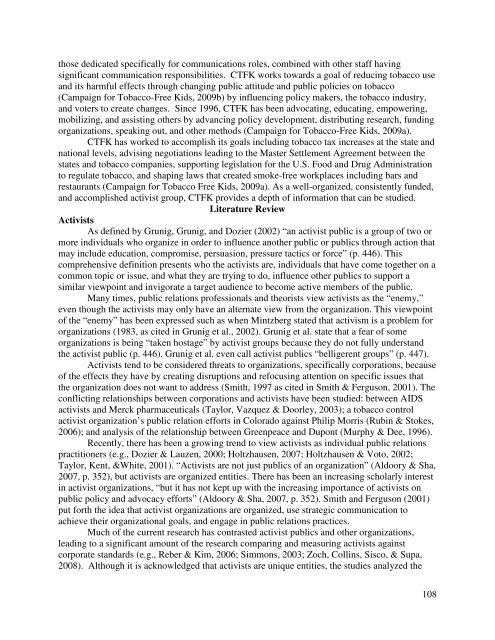2010 - Public Relations Society of America
2010 - Public Relations Society of America
2010 - Public Relations Society of America
You also want an ePaper? Increase the reach of your titles
YUMPU automatically turns print PDFs into web optimized ePapers that Google loves.
those dedicated specifically for communications roles, combined with other staff having<br />
significant communication responsibilities. CTFK works towards a goal <strong>of</strong> reducing tobacco use<br />
and its harmful effects through changing public attitude and public policies on tobacco<br />
(Campaign for Tobacco-Free Kids, 2009b) by influencing policy makers, the tobacco industry,<br />
and voters to create changes. Since 1996, CTFK has been advocating, educating, empowering,<br />
mobilizing, and assisting others by advancing policy development, distributing research, funding<br />
organizations, speaking out, and other methods (Campaign for Tobacco-Free Kids, 2009a).<br />
CTFK has worked to accomplish its goals including tobacco tax increases at the state and<br />
national levels, advising negotiations leading to the Master Settlement Agreement between the<br />
states and tobacco companies, supporting legislation for the U.S. Food and Drug Administration<br />
to regulate tobacco, and shaping laws that created smoke-free workplaces including bars and<br />
restaurants (Campaign for Tobacco Free Kids, 2009a). As a well-organized, consistently funded,<br />
and accomplished activist group, CTFK provides a depth <strong>of</strong> information that can be studied.<br />
Literature Review<br />
Activists<br />
As defined by Grunig, Grunig, and Dozier (2002) “an activist public is a group <strong>of</strong> two or<br />
more individuals who organize in order to influence another public or publics through action that<br />
may include education, compromise, persuasion, pressure tactics or force” (p. 446). This<br />
comprehensive definition presents who the activists are, individuals that have come together on a<br />
common topic or issue, and what they are trying to do, influence other publics to support a<br />
similar viewpoint and invigorate a target audience to become active members <strong>of</strong> the public.<br />
Many times, public relations pr<strong>of</strong>essionals and theorists view activists as the “enemy,”<br />
even though the activists may only have an alternate view from the organization. This viewpoint<br />
<strong>of</strong> the “enemy” has been expressed such as when Mintzberg stated that activism is a problem for<br />
organizations (1983, as cited in Grunig et al., 2002). Grunig et al. state that a fear <strong>of</strong> some<br />
organizations is being “taken hostage” by activist groups because they do not fully understand<br />
the activist public (p. 446). Grunig et al. even call activist publics “belligerent groups” (p. 447).<br />
Activists tend to be considered threats to organizations, specifically corporations, because<br />
<strong>of</strong> the effects they have by creating disruptions and refocusing attention on specific issues that<br />
the organization does not want to address (Smith, 1997 as cited in Smith & Ferguson, 2001). The<br />
conflicting relationships between corporations and activists have been studied: between AIDS<br />
activists and Merck pharmaceuticals (Taylor, Vazquez & Doorley, 2003); a tobacco control<br />
activist organization’s public relation efforts in Colorado against Philip Morris (Rubin & Stokes,<br />
2006); and analysis <strong>of</strong> the relationship between Greenpeace and Dupont (Murphy & Dee, 1996).<br />
Recently, there has been a growing trend to view activists as individual public relations<br />
practitioners (e.g., Dozier & Lauzen, 2000; Holtzhausen, 2007; Holtzhausen & Voto, 2002;<br />
Taylor, Kent, &White, 2001). “Activists are not just publics <strong>of</strong> an organization” (Aldoory & Sha,<br />
2007, p. 352), but activists are organized entities. There has been an increasing scholarly interest<br />
in activist organizations, “but it has not kept up with the increasing importance <strong>of</strong> activists on<br />
public policy and advocacy efforts” (Aldoory & Sha, 2007, p. 352). Smith and Ferguson (2001)<br />
put forth the idea that activist organizations are organized, use strategic communication to<br />
achieve their organizational goals, and engage in public relations practices.<br />
Much <strong>of</strong> the current research has contrasted activist publics and other organizations,<br />
leading to a significant amount <strong>of</strong> the research comparing and measuring activists against<br />
corporate standards (e.g., Reber & Kim, 2006; Simmons, 2003; Zoch, Collins, Sisco, & Supa,<br />
2008). Although it is acknowledged that activists are unique entities, the studies analyzed the<br />
108
















